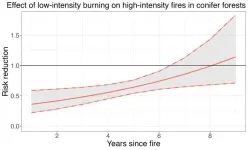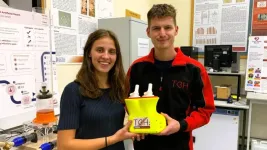(Press-News.org) LA JOLLA, CA—Scientists at La Jolla Institute for Immunology (LJI) are investigating a talented type of T cell.
Most T cells only work in the person who made them. Your T cells fight threats by responding to molecular fragments that belong to a pathogen—but only when these molecules are bound with markers that come from your own tissues. Your influenza-fighting T cells can't help your neighbor, and vice versa.
"However, we all have T cells that do not obey these rules," says LJI Professor and President Emeritus Mitchell Kronenberg, Ph.D. "One of these cell types is mucosal-associated invariant T (MAIT) cells."
Now Kronenberg and his LJI colleagues have uncovered another MAIT cell superpower: MAIT cells can recognize the same markers whether they come from humans or mice. Kronenberg calls this finding "astounding." "Humans diverged from mice in evolution 60 million years ago," he says.
This new research, published in Science Immunology, sheds light on the genes and nutrients that give MAIT cells their fighting power. The findings are an important step toward one day harnessing these cells to treat infectious diseases and improve cancer immunotherapies.
"Because MAIT cells are the same across individuals, they could more easily be used in cell therapies, where, in principle, my MAIT cells could be given to you," says Kronenberg.
The new study also opens the door to exploiting MAIT cells to improve cellular therapies. "If we could make normal T cells more like MAIT cells, maybe we could make them act faster and more vigorously to combat any type of infection or cancer," says study co-first author Gabriel Ascui, a UC San Diego graduate student in LJI's Kronenberg Lab.
Why MAIT cells are special
Kronenberg was initially interested in MAIT cells because of their unexpected response speed. Typical T cells need a few days to develop in the thymus and only adapt to fighting new threats after leaving the thymus—and after several days of stimulation from a pathogen. MAIT cells are much faster because they can respond to more generic markers of infection, rather than hunting for very specific tissue-type markers. For MAIT cells, a red flag is a red flag, no matter who is waving it.
This broad specificity makes MAIT cells similar to the immune system's first-responder cells, such as macrophages and neutrophils, which make up the "innate" immune system. "MAIT cells have this 'innate-like' characteristic," says Ascui. "They're like your first line of defense." In fact, MAIT cells tend to gather in tissues like the lungs and intestines, where the body is under constant threat from airborne and foodborne pathogens.
The new study shows that MAIT cells don't just recognize a range of markers within one person. Instead, these odd T cells can "see" markers shared between humans—and even between species. Scientists call these kinds of shared markers "conserved." There has been no reason for the markers to change over the eons, so they remain the same across related species.
But just because these MAIT cells look the same between species, doesn't mean they fight pathogens—or make energy—in exactly the same ways.
Why look at mouse cells?
Comparing human and mouse MAIT cells is important for guiding future studies where mice can serve as useful animal models to study exactly how these cells combat pathogens.
Kronenberg, Ascui, and their colleagues used single-cell sequencing and other tools to compare differences in gene expression pathways between human and mouse MAIT cells. The scientists found that mice have two different kinds of MAIT cells, which produce different inflammatory molecules, called cytokines. One kind of MAIT cell, which the scientists call MAIT1, produces a lot of a cytokine called interferon-gamma. The other kind of the MAIT cell, called MAIT 17, produces a lot of a cytokine called interleukin-17.
A recent Nature Cell Biology study from the Kronenberg Lab, co-led by LJI Instructor and Immunometabolism Core Director Tom Riffelmacher, Ph.D., shows that after a bacterial infection, MAIT1 and MAIT17 cells persist but become super-charged, or capable of having greater protective function for months. These cytokines help the MAIT cells take aim at different threats. MAIT1 cells target viruses such as influenza, while MAIT17 cells are better at targeting bacteria.
In the new study, the team found that MAIT cells from both species are more capable of taking up and storing fat, compared with typical T cells. This finding suggests MAIT cells are more dependent on this nutrient for energy. This discovery is also in line with previous work in the Kronenberg Lab showing that some MAIT cells depend on fat to fight pathogens. The key difference between the species was that human MAIT cells can produce interferon-gamma and IL-17, but not evidently by separate cell populations.
When mice live like us
The scientists needed to know—was this difference in human and mouse MAIT cells linked to genetic differences or to our different habitats? Lab mice, such as those cared for at LJI, are housed in ultra-clean vivariums. Their food is blasted in an autoclave to kill pathogens, and their water, toys, and cages are kept as sterile as possible.
Kronenberg and Ascui were curious—do mice living in less-controlled environments show differences in MAIT cell function? The team collaborated with UC San Diego scientists to study MAIT cells from mice kept in so-called "dirty" or less sterile conditions, similar to a pet store environment. Their research suggests MAIT cells from these mice have even more in common with human MAIT cells, especially when it came to having more MAIT1 cells, which produced more interferon-gamma than lab mouse MAIT1 cells.
"Pet stores aren't dirty in the conventional sense," says Kronenberg. "But part of the idea is that the 'dirty' mice are living in an environment—with more microbes and immune system challenges—that's a little closer to human environments."
The team also compared MAIT cells found in different parts of the body, such as the blood, thymus (where T cells, including MAIT cells, develop), and the lung and spleen (where MAIT cells camp out). They discovered that MAIT cells still in the thymus look very similar between humans and mice ("dirty" or not); however, MAIT cells from the lungs and blood are more different between humans and lab mice.
MAIT cells from the "dirty" mice fell between the two groups, adding to the evidence that more natural-like environments change how MAIT cells develop and learn to target disease.
"Environmental, as well as genetic differences, shape the species differences in these cells," says Kronenberg.
What does this mean for clinical research?
The new study gives scientists a sort of answer key, a list of genetic signatures to tell MAIT cells apart depending on the species and tissues they come from. Going forward, the team is interested in whether they can prompt typical T cells to express similar genetic signatures.
"If we could make normal cells more 'innate,' like MAIT cells, perhaps we could improve T cell therapy for cancer," says Ascui. "That's one avenue we're looking at."
Kronenberg is also interested in whether scientists can modify MAIT cells to actually decrease levels of IL-17 in the body. Although IL17 helps fight infections, some T cells produce IL-17 against the wrong targets, triggering harmful inflammation and even autoimmune disease.
"There are cases where IL-17 can be a bad actor," says Kronenberg. "So although there are cases where we might want to induce more MAIT17 cells, expand their population, but we'd also like to find ways to prevent them from arising in situations where they might not be what we want."
Additional authors of the study, "Transcriptomes and metabolism define mouse and human MAIT cell populations," include co-first authors Shilpi Chandra and Thomas Riffelmacher, and Ashu Chawla, Ciro Ramírez-Suástegui, Viankail C. Castelan, Gregory Seumois, Hayley Simon, Mallory P. Murray, Goo-Young Seo, Ashmitaa L. R. Premlal, Benjamin Schmiedel, Greet Verstichel, Yingcong Li, Chia-Hao Lin, Jason Greenbaum, John Lamberti, Raghav Murthy, John Nigro, Hilde Cheroutre, Christian H. Ottensmeier, Stephen M. Hedrick, Li-Fan Lu, and Pandurangan Vijayanand.
This research was supported by the National Institutes of Health (AI105215, AI71922, AI137230, AI108651, AI163813, S10RR027366, S10OD025052, S10-OD016262), the Wellcome Trust (grant 210842_Z_18_Z); UC San Diego Program in Immunology seed grant, the Whittaker Fund, iCURE, and the Wessex Clinical Research Network.
Special Notes to Reporters: More information, including a copy of the paper, can be found online at the Science Immunology press package at https://www.eurekalert.org/press/immunopak/.
About La Jolla Institute
The La Jolla Institute for Immunology is dedicated to understanding the intricacies and power of the immune system so that we may apply that knowledge to promote human health and prevent a wide range of diseases. Since its founding in 1988 as an independent, nonprofit research organization, the Institute has made numerous advances leading toward its goal: life without disease. Visit lji.org for more information.
END
A closer look at rebel T cells
LJI researchers investigate a group of T cells known for their unusual response to pathogens
2023-11-10
ELSE PRESS RELEASES FROM THIS DATE:
Low-intensity fires reduce wildfire risk by 60%, according to study by Columbia and Stanford researchers
2023-11-10
There is no longer any question of how to prevent high-intensity, often catastrophic, wildfires that have become increasingly frequent across the Western U.S., according to a new study by researchers at Stanford and Columbia universities. The analysis, published Nov. 10 in Science Advances, reveals that low-intensity burning, such as controlled or prescribed fires, managed wildfires, and tribal cultural burning, can dramatically reduce the risk of devastating fires for years at a time. The findings – some of the first to rigorously quantify the value of low-intensity fire – come while Congress is reassessing the U.S. Forest Service’s ...
Unlocking the secrets of spin with high-harmonic probes
2023-11-10
Deep within every piece of magnetic material, electrons dance to the invisible tune of quantum mechanics. Their spins, akin to tiny atomic tops, dictate the magnetic behavior of the material they inhabit. This microscopic ballet is the cornerstone of magnetic phenomena, and it's these spins that a team of JILA researchers—headed by JILA Fellows and University of Colorado Boulder professors Margaret Murnane and Henry Kapteyn—has learned to control with remarkable precision, potentially redefining the future of electronics and data storage.
In a new Science Advances ...
University of Minnesota Medical School researchers investigate cause of cardiomyopathy in coronary artery disease using cardiac MRI
2023-11-10
MINNEAPOLIS/ST. PAUL (11/10/2023) — Researchers from the University of Minnesota Medical School examining the cause of cardiomyopathy discovered one out of every six patients with coronary artery disease had non-ischemic or dual cardiomyopathy.
The findings of this study were published this week in the peer-reviewed journal Circulation, the flagship journal of the American Heart Association.
Cardiomyopathies are diseases of the heart muscle. Patients with coronary artery disease can have cardiomyopathy from heart muscle ...
Heart of Gold: Bath student team wins world Heart Hackathon competition
2023-11-10
Student engineers from the University of Bath are on top of the world after winning an international competition to design an artificial heart.
Team Bath Heart took top prize at the grand final of the first-ever Heart Hackathon, which was held in Texas at the end of October.
Six members of the team presented their device to global experts in artificial heart technologies, competing against teams from Australia, the United States, Sweden, New Zealand, Romania and Egypt.
The ‘total artificial heart’ ...
Cleveland Clinic research links sleep apnea to increased risk of atrial fibrillation
2023-11-10
New research from Cleveland Clinic has identified a link between sleep apnea and the development of atrial fibrillation, a common heart rhythm disorder.
Published in JAHA, the study of over 42,000 patients found that sleep-related hypoxia - or low oxygen levels during sleep - is associated with a higher risk of developing atrial fibrillation over time. The study found this risk persisted even after accounting for lung function, suggesting sleep-related hypoxia independently increases atrial fibrillation risk separate from any underlying lung disease.
Atrial fibrillation causes an irregular ...
New approach to pancreatic cancer treatment expands therapeutic possibilities, shows promise for increased survival
2023-11-10
Preclinical research published in the Journal for ImmunoTherapy of Cancer points to a promising new treatment option for people with pancreatic cancer. Researchers from VCU Massey Comprehensive Cancer Center and the VCU Institute of Molecular Medicine (VIMM) suggest that when used in a form that can be delivered directly into the tumor cell, polyinosine–polycytidylic acid (pIC) suppresses tumor growth, induces cancer cell death and enhances survival in animal models with the most common form of pancreatic cancer.
Researchers also concluded that when used alone ...
UTHealth Houston partners with Mexican organizations for $5 million NIH grant to improve implementation of cancer control interventions in Mexico and Latin America
2023-11-10
A five-year, $5 million grant has been awarded by the National Cancer Institute (NCI) to the UTHealth Houston Institute for Implementation Science to support research and training in implementation science, with a focus on improving cancer control efforts in Mexico and Latin America.
The grant brings together researchers from UTHealth Houston, the Mexican National Institute of Public Health (INSP), the Mexican National Cancer Institute (INCan), and the University of California San Francisco (UCSF).
The grant will fund a new center, LISTOS for Cancer Control – Leveraging Implementation ...
Yucatán’s underwater caves host diverse microbial communities
2023-11-10
Cave divers collected 78 water samples throughout the complex web of underwater caves
Researchers found the cave system’s microbiome is distinct from the nearby sea
Microbial communities vary between cave systems forming distinct “neighborhoods”
EVANSTON, Ill. — With help from an experienced underwater cave-diving team, Northwestern University researchers have constructed the most complete map to date of the microbial communities living in the submerged labyrinths beneath Mexico’s Yucatán Peninsula.
Although previous researchers have collected water and microbial samples from the ...
A catalyst for change: New research aims to design atomically efficient and selective catalysts
2023-11-10
Most of us understand that electrical engineering and mechanical engineering play a key role in running our washing machines or our computers. But did you know that more than 80 percent of the products we use every day, such as fertilizers, cosmetics, fragrances, rubber and more, require some sort of chemical catalyst while being manufactured?
Catalysts are like turbochargers for chemical reactions. Until now, the process of designing a catalyst for chemical reactions has been mostly trial ...
Study finds tapering TNF inhibitors increases flares, lowers boolean remission rates for RA patients in remission
2023-11-10
ATLANTA — New research at ACR Convergence 2023, the American College of Rheumatology’s (ACR) annual meeting, found that rheumatoid arthritis (RA) patients in sustained remission who stopped TNF inhibitors (TNFi) had significantly more flares and lower Boolean 2.0 remission rates compared with those who continued treatment. Boolean 2.0 is a revised definition for evaluating disease activity in RA that classifies more patients as achieving remission than Boolean 1.0. It is endorsed by the American College of Rheumatology and the European Alliance for Associations in Rheumatology (EULAR) (Abstract #L07).
As more RA patients ...
LAST 30 PRESS RELEASES:
UMass Amherst chemists develop unique tool for studying RNA
Disappointment alters brain chemistry and behavior
A built-in odometer: new study reveals how the brain measures distance
Stress-related brain signals drive risk of cardiovascular disease in people with depression and anxiety
New details on role of fat transport molecules in Alzheimer’s onset
Study illuminates how an antiviral defense mechanism may lead to Alzheimer’s disease
Spot the males: New gene-editing method could transform mosquito control
AI learns to build simple equations for complex systems
NAU team releases 13 years of detailed U.S. CO2 emissions data
Unveiling how sodium-ion batteries can charge faster than lithium-ion ones
How do childcare tax credits affect children’s long-term health?
Can an electronic nose detect indoor mold?
Do natural disasters have long-term impacts on mortality in older adults?
Modification improves sodium‐ion batteries as an alternative to lithium-ion batteries
Parasports provide a range of benefits for people with cerebral palsy
How does grandparental care affect children’s health?
Why are there so many Nordic mediators?
Young shark species more vulnerable to extinction
Mobile fetal heart monitoring linked to fewer newborn deaths in Tanzania
Bluey’s dad offered professorial chair in archaeology at Griffith University
Beyond small data limitations: Transfer learning-enabled framework for predicting mechanical properties of aluminum matrix composites
Unveiling non-thermal catalytic origin of direct current-promoted catalysis for energy-efficient transformation of greenhouse gases to valuable chemicals
Chronic breathlessness emerging as a hidden strain on hospitals
Paleontologists find first fossil bee nests made inside fossil bones
These fossils were the perfect home for ancient baby bees
Not everyone reads the room the same. A new study examines why.
New research identifies linked energy, immune and vascular changes in ME/CFS
Concurrent frailty + depression likely boost dementia risk in older people
Living in substandard housing linked to kids’ missed schooling and poor grades
Little awareness of medical + psychological complexities of steroid cream withdrawal
[Press-News.org] A closer look at rebel T cellsLJI researchers investigate a group of T cells known for their unusual response to pathogens






